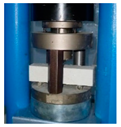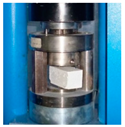Abstract
The paper describes the process of obtaining geopolymer composites using raw materials from critical waste, i.e., mixed power plant ash and furnace slag powder. Using such geopolymer composites, structural insulation panels were made in the laboratory, which were subjected to tests specific to construction applications. At the same time, some special properties, such as sound insulation and electromagnetic shielding properties for special applications, were tested. The results obtained from the functional tests led to the conclusion that the panels made of geopolymer composites provided both sound and electromagnetic attenuation values clearly superior to those obtained from autoclaved cellular concrete, brick, or concrete structures, which encourages us to suggest such material concepts for complex shielding purposes. The sustainability of the technology for producing such geopolymer composites was fully demonstrated from the economic, environmental, and social perspectives.
1. Introduction
The large volume of waste generated nowadays constitutes a serious problem both for the environment and for populations living near their storage areas [1,2,3,4]. Another problem associated with obtaining construction materials, mainly concrete based on Portland cement, is the exploitation of non-renewable raw materials, namely, limestone and clay, which also involves high energy consumption [5,6]. Their global consumption is currently about 20,000 million tons/year and an annual increase of 4.7% is expected [7]. More than a third of this consumption is related to the production of concrete, being the most used construction material on Earth, currently exceeding 10 km3/year [8]. Since the cost of the raw material depends a lot on the cost of transportation, this leads to their exploitation from areas as close as possible to the construction sites, which induces the accelerated multiplication of the number of quarries and a consequential increase in the impact on biodiversity. Therefore, in order to reduce the consumption of raw materials and energy, in recent years, emphasis has been placed, on a global scale, on the reuse of materials produced as waste in other technologies, with their possible integration into construction materials [9,10,11,12,13]. A simple technique of increasing interest that can generate construction materials with similar properties to concrete or Portland cement-based mortar and, at the same time, integrate critical raw materials as a raw material source, is geopolymerization [14,15,16,17]. Geopolymerization is the chemical reaction of dissolving a material rich in silicon and aluminum oxides under the action of an alkaline solution and forming a Si-O-Al tetragonal structure by partially removing water. Therefore, a geopolymer is an oxide material based on aluminum and silicon formed following the geopolymerization reaction [18,19]. From a microstructural point of view, geopolymer binders are predominantly amorphous, the reaction product, resulting from the alkaline activation of the alumino-silicate material, being an alkaline hydroalumino-silicate gel, in which unreacted crystalline phases from the initial material can be embedded or produced due to a reaction with a certain degree of crystallinity, of the zeolite type.
Ideally, geopolymers are formed by tetrahedral bonds between aluminum and silicon joined by oxygen atoms. A polymeric structure of Al-O-Si bonds is shown in Figure 1 and represents the essential elements of the geopolymer structure.

Figure 1.
Geopolymer structure represented by Al-O-Si bonds [19].
Geopolymers were first tested as construction materials for the manufacture of panels with high fire resistance [20]. Later, due to the advantages they present compared to conventional materials, geopolymers were introduced in the automotive, ceramics, metallurgical, aerospace, and other industries. According to the specialized literature, any material in powder form with a high content of aluminum and silicon oxides can be used as a raw material for geopolymers [20]; however, the method of obtaining must be customized according to the desired final characteristics. In a recent study [21], the potential of geopolymers as insulation materials is widely described alongside the contribution of geopolymers to sustainability in the construction industry. Meanwhile, an earlier study [22] evaluated the environmental protection potential of using geopolymer-based concrete in the production of green buildings, creating new materials that had similar, or even better, mechanical qualities than conventional cement-based materials. The technology for obtaining cement for construction is known to be highly polluting because it produces high levels of CO2 emissions [23,24]. Conversely, technologies for making structural insulation panels based on gypsum, anhydrous absorbent montmorillonite, and geopolymer with various additions provided a significant reduction in greenhouse gas emissions compared to current equivalent products incorporating primary concrete components [25].
Greenhouse gas emissions in the case of geopolymer composite panels for special constructions are approximately 60% lower than in the case of conventional prefabricated concrete panels (Figure 2 and Figure 3). Although geopolymers have been investigated in various stages for over 25 years, geopolymers do not yet have large-scale applications. In fact, despite a wide range of applications being described in the literature, only a few niche applications can actually be found in the real world. This is surprising, especially as geopolymers offer several advantages compared to cement based on composite or ceramic materials: resistance to acids; resistance to high temperatures; high mechanical resistance; high durability; cold workability; stable junction with heavy metals and harmful substances; and relatively simple manufacturing techniques.
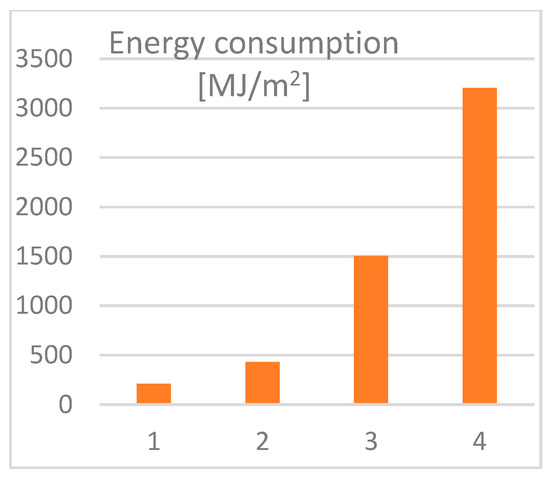
Figure 2.
Energy consumption for obtaining 1 m2 panel (MJ/m2) (1) of geocomposite with waste inserts; (2) from autoclaved concrete; (3) from cellular concrete; and (4) with a double brick structure (with data from [5,8,9]).
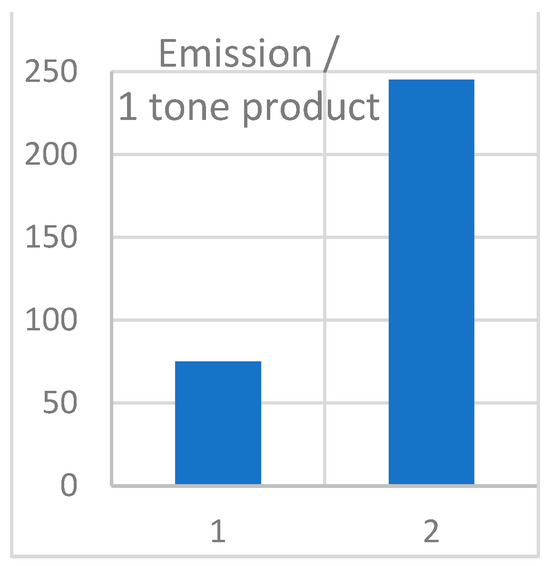
Figure 3.
Emission of greenhouse gases for obtaining 1000 kg of product: (1) geocomposite panel with waste inserts; (2) panel based on Portland concrete (with data from [5,8,9]).
In addition to recovering waste that is difficult to integrate with other technologies, the use of fly ash in geopolymer composites has reduced demand for the manufacture of cement clinker, a major source of carbon emissions. As such, some ideas from a study by Rangan [26], in the context of green buildings, provide the ideal environment for a rethinking of insulating materials. Investigating the insulating characteristics of geopolymers has shown their potential in the energy efficiency of buildings. In this sense, in Fernandez-Jimenez and Palomo [27] and Santa et al. [28], perspectives highlighting the crucial role of geopolymers in maintaining ideal indoor temperatures in building interiors, and maximizing energy savings are described. Conversely, the ability of geopolymers to resist mechanical actions without maintenance or loss in performance and also to survive aggressive environments to which they are exposed through the service life was emphasized in two further studies [29,30].
Fire resistance remains one of the most important priorities in the construction industry. The excellent fire-resistant properties of geopolymers have attracted much interest and taken green buildings to new levels of strength and safety. Thus, the work carried out by Hassan et al. [31] opened a new research area in greenhouse safety by highlighting the excellent fire resistance qualities without suffering significant structural losses of geopolymer-based materials. Similar results were emphasized in two further studies [32,33]. Another important benefit of using geopolymer composites is related to their peculiar resistance in liquid media, as described in several studies [34,35,36,37] that concern mainly acid or saline media. Conversely, very few studies tried to address other features e.g., the thermal, acoustic, or electromagnetic shielding properties of geopolymer-related materials. As concerns thermal insulation, mostly foam structures were investigated, and the insulation features were found to be based on the quantity of accumulated air within the structure (e.g., [38,39]). The acoustic performance has not been separately discussed but instead included within the generic physical properties of investigated geopolymer composites (e.g., [40,41]) without emphasizing a real application of such structures for acoustic insulation purposes. Finally, some studies (e.g., [42,43]) emphasized the electromagnetic properties of geopolymer composites, mainly related to the GHz domain, but the recipes for these materials included either iron powder/iron ore fine or carbon powder/fibers, materials known to enhance the electromagnetic shielding properties by themselves, so the geopolymer recipe in fact makes no contribution. It must be mentioned that such compositions are far from normal for geopolymer materials, made with high costs, and address a disputable market, related mainly to electronic applications, in which other types of composites are more suitable for use (see, for example, [44,45,46,47]).
This paper describes the process to obtain geopolymer composites using raw materials from critical waste, i.e., power plant ash and furnace slag. Based on such geopolymer composites, structural insulation panels were made in the laboratory that were subjected to tests specific to construction applications (apparent density, mechanical resistance to stretching and compression, resistance and thermal conductivity, flame resistance). The study was extended to assess the corrosion resistance of polymer composites in liquid media with new liquids being tested, namely, acetic acid and synthetic engine oil, for the potential use of the composites as specific containers. At the same time, some special properties, such as sound insulation and electromagnetic shielding properties for special applications, were tested. The need for such research is related, firstly, to the sustainable integration of critical waste within new recipes of building materials, and secondly, to the need to develop new concepts of shielding in construction. The results obtained from the functional tests led to the conclusion that the panels made of geopolymer composites provided both sound and electromagnetic attenuation values clearly superior to those obtained from autoclaved cellular concrete, brick, or concrete structures, which encourages us to suggest such material concepts for complex shielding purposes. The sustainability of the technology for producing such geopolymer composites was fully demonstrated from the economic, environmental, and social perspectives.
2. Materials and Methods
2.1. Equipment Used
The following equipment was used to obtain and characterize these geopolymers:
2.1.1. The Equipment Used to Obtain Geopolymer Composites
- Hobart Mixer;
- Roller crusher for shredding;
- Vibrating table—to eliminate bubbles;
- Programmable Memmert UF model oven.
2.1.2. The Equipment Used for the Characterization of Geopolymer Composites
- The mechanical tests were carried out with a universal machine for mechanical tests up to 30 kN [48];
- Tests to determine the specific surface area and porosity were carried out with Surface Area and Porosity Analyzer (BET equipment) [49];
- Structural analyses (X-ray Diffraction and Energy-dispersive X-ray Spectroscopy) were carried out with a scanning electron microscope with a field emission source and a focused ion beam;
- Fourier Transform Infrared Spectroscopy was performed with a JASCO FTIR 4200 spectrometer [50];
- Portable stand for dielectric measurements (network analyzer);
- Brüel & Kjaer acoustic interferometer, acoustic interferometer (Kundt tube), power amplifier and analyzer [51];
- The determination of the effectiveness of the electromagnetic shielding was carried out by applying the coaxial transmission line method and measuring the reflection in free space.
2.2. Obtaining the Geopolymer Composite
For the preparation of geopolymer composites, thermal power plant ash and furnace slag powder of Romanian origin were used as raw materials. A centrifugal selector (ex. 100 MZR Alpine, Hosokawa Micron Ltd., Runcorn, UK) was used to obtain very fine raw materials. By varying the sieving speed (rotation speed of the disk) and the air current, different granulations of material are obtained. The smaller the particle size of the raw material, the higher the rate of geopolymerization and reactivity of the geopolymer composites.
As regards the power plant ash, it dispersed very efficiently within the centrifugal selector and the resulting particle average size was under 20 μm with a D50 of 9.1 μm.
The furnace slag was firstly processed by using a roller crusher before submitting the powder to the centrifugal selector, and the resulting particle average size was under 100 μm with a D50 of 44.6 μm. The specific surface of power plant ash and furnace slag powder can vary between 150 and 300 m2/kg.
The chemical composition and concentration of the additives are given in Table 1.

Table 1.
Chemical composition and concentration of the additives.
The chemical composition was determined by classical structural analyses, Section 2.1.2.
Analyzing the compositional differences between thermal power plant ash (based mainly on lignite) of Romanian origin from different industrial sources led to the conclusion they did not exceed approximately ±5% (the comparison was made among 5 large thermal power plants in Romania: Iernut, Rovinari, Turceni, Comanesti, and Brazi). Similarly, analyzing the compositional differences between furnace slag powder of Romanian origin from different industrial sources (3 steel plants: Galati, Hunedoara, and Targoviste) led to the same conclusion. Consequently, the conclusions related to the use of such raw materials for geopolymer composites are generally conclusive at least at a national scale. Metakaolin used was also analyzed, as it is a common ingredient in classical geopolymer composites, [52,53]. As we can see from Table 1, the ash presents high concentrations of SiO2 and Al2O3, close to metakaolin homolog concentrations, while the slag powder presents a much lower concentration of Al2O3 but relatively significant concentrations of Fe2O3, CaO, and MgO, which may provide interesting electromagnetic properties to the final composites. Generally, it can be said that the ash from power plants may successfully substitute metakaolin, significantly lowering the production cost of composites and assuring the sustainability concept for geopolymer composite concrete. At the same time, the use of dry ash from power plants eliminates the additional process of calcining at high temperatures, as, for example, metakaolin is obtained by calcining kaolin at 750 °C for 6 h (see, for example, [53]). Technologically obtained metakaolin presents a particle size under 20 μm with a D50 of about 8.5 μm, very similar to the dimension of ash particles. In all, the use of critical wastes such as power plant ash and furnace slag powder for the fabrication of geopolymer composite concrete brings high economic and environmental benefits when substituting energy-consuming raw materials such as metakaolin.
The technological obtaining of geopolymer concrete used an alkaline activator—NaOH 7–12M solution—dosed in the binder mixtures as a dry substance. The power plant ash and furnace slag powder in different proportions are firstly mixed with the sodium hydroxide solution in a Hobart mixer for about 10 min at a speed of 285 ± 10 rpm. The ratio of SiO2 to Na2O in the alkaline adhesive can be changed either by modifying the NaOH solution concentration or quantity or by adding extra Na2O powder in cases where additional additives are added, i.e., sand or gravel. In our case, sand for construction of river origin with grit under 2 mm, (supplied by the Adeplast Company, Romania), containing 93–95% SiO2 and a mass of about 30% of the initially processed solid ash-slag mass, was added and the mixing was continued for another 5 min with extra NaOH solution, in order to obtain a geopolymer micro-concrete. The material thus obtained was poured into molds and subjected to a vibration process for 5 min in order to release the remaining air bubbles. This operation is very important because it ensures homogeneity, increases strength, and eliminates segregation. After removing the bubbles, the molds were kept at 60 °C for 3 h in a drying oven. After being removed from the molds, the samples were hydrothermally treated at 100 °C for 24 h and then kept in the laboratory atmosphere at a relative humidity of 40–60%. In parallel, for comparison, a series of samples were kept only in the laboratory atmosphere, before starting the measurement of physical and mechanical properties.
In Table 2, the sample codes and concentrations of the obtained geopolymers are presented. Samples P1–P3 contain equal quantities of power plant ash and furnace slag (mass report of power plant ash and furnace slag 1:1), but different concentrations of the alkaline activator, following the methodology as described also in [52,53]. Samples P4–P6 retain the same concentration of the alkaline activator (10 M) but the ratio of power plant ash to furnace slag varies from 3:1 and 2:1 to 1:2.

Table 2.
Samples codes and concentrations.
The rheological properties of the geopolymer compositions are dependent on the waste content in the mixture. Compared to cement concretes, mixtures containing a higher percentage of waste present a different rheological behavior. Both statically and dynamically, the viscosity of geopolymer is substantially higher. Consequently, longer vibration treatments or other processing techniques are required. The mixing process of all geopolymer components ensures a perfect dispersion of even the smallest particles. However, the faster mixing required for geopolymer compounds results in the entrainment of a considerable amount of air into the freshly formed concrete. This air, which is present as small bubbles throughout the volume of the composition, cannot be removed in a reasonable period of time, because the mobility of the binder components is low; therefore, a significant part of the air remains trapped following the mixing process. It could be observed from the microscopic images that the air appears in the form of closed pores that the water cannot reach. A larger quantity of air is not desirable, as it may impact mechanical properties. However, at the same time, a lower residual quantity of air within closed pores may favorably impact thermal insulation properties.
2.3. Characterization of the Obtained Geopolymer Composites
2.3.1. Compression Resistance Tests
The compression strength values of the geopolymer mixtures show an increasing trend after 1–28 days from the time of their preparation. After 28 days, the values remain practically constant. Depending on the preparation conditions and their composition, the respective values varied between 30 and 70 Mpa after 28 days. In general, the strength depends on the initial concentration of NaOH, being superior for a higher content after 28 days (Figure 4). The highest resistance value was achieved for the geopolymer with the highest content of ash (P4), which can be explained by the higher ratio of SiO2/Al2O3 (Figure 5).
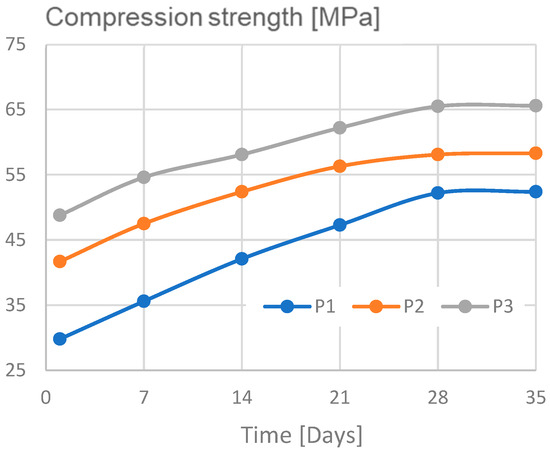
Figure 4.
Compression strength evolution vs. time.
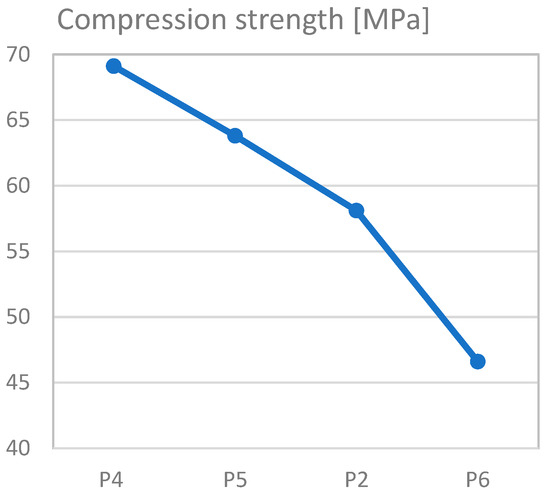
Figure 5.
Compression strength variation vs. ash content.
As regards the samples submitted to hydrothermal treatment, compression strength tests were performed and compared with those of the samples submitted to laboratory atmosphere also for 2 h, 5 h, and 24 h following their preparation. It was noticed that the hydrothermal treatment results in higher aggregated values in the first 24 h, which can be explained by a forced maturation of composites in the first stage (Table 3); for example, after 5 h, the compression strength for samples with hydrothermal treatment reaches about 63.7% of the final value, comparing to only 31.7% in the case of samples without hydrothermal treatment. However, it should be noted that, after 28 days, the values for samples with hydrothermal treatment are quite similar to the values for samples without hydrothermal treatment, so hydrothermal treatment is not necessary if the maturation period exceeds 28 days. However, if some applications require shorter periods between geopolymer composite production and use, hydrothermal treatment may be taken into account as a useful procedure, and the materials can even be used only after 24 h of maturation when the compression strength reaches about 74.5% of the final value.

Table 3.
Compression resistance after hydrothermal treatment for P2 sample.
Two aspects are considered important for the construction industry:
- No shrinkage occurs due to hydration in the geopolymer; therefore, the volume in the fresh state is kept as a permanent value. In this way, the geopolymer composites are superior to cement-based aggregates;
- The ratio between compressive strength and tensile strength varies in the range of 10.0:5.5, under the circumstances that the ratio for cement-based aggregates varies from 10.0:1.0 to 10.0:1.5, which means that a higher tensile strength of the geopolymer offers the possibility of reducing the amount of reinforcement in the structural elements.
2.3.2. Physical Properties
The physical properties of geopolymers obtained from ash and furnace slag under different conditions depend on their densities, which vary from 1198 to 1292 kg/m3. The highest values correspond to the highest concentration of alkaline activator (P3) and highest content of ash (P4), respectively (Table 4).

Table 4.
Physical properties.
Water absorption varies between 16.91 and 22.78% and increases mainly with the increase in concentration of furnace slag (maximum for P6).
Geopolymers present a fairly high porosity (up to 35%), regardless of the conditions that exist during their preparation. Spherical closed pores of entrained air, formed as a result of the dissolution of ash particles during preparation, are present. The preparation conditions, namely, the Na2O content and the SiO2-to-Na2O ratio, affect not only the obtained strength values but also the pore size distribution. The porosity of the polymers is also substantially influenced by the value of the water coefficient (H2O-to-ash ratio). The porosity of the geopolymers prepared from a mixture of ash and slag was significantly lower at a higher percentage of ash (P4) and a higher value of Na2O/H2O (P3), and in these cases, smaller pores were observed.
3. Experimental Section: Structural Insulation Panels Based on Geopolymer Composites
3.1. Manufacture of Structural Insulation Panels
Following the results of the characterization tests described above, which demonstrated that composites formed of ash and slag in a 1:1 ratio offer superior performance at higher concentrations of alkaline adhesive agent, the composition for manufacturing structural insulation panels was chosen to be: 60% power plant ash and furnace slag (mass report 1:1), 14% alkaline adhesive agent NaOH—12 M solution, 7% montmorillonite anhydrous absorbent ((Na,Ca)0.33(Al,Mg)2(Si4O10)(OH)2), and the remainder, sand, with water to ensure workability. The power plant ash and furnace slag were as described in Table 1. The montmorillonite for building industry use was purchased from Mapei Industry (Romania) and its properties were: free expansion [54]: >27 mL/2 g; fluid loss [55]: <18 mL; water absorption [56]: >750%; viscosity in a Marsh 1500/1000 tunnel: 38–40; and filtered water pH: 9. The sand for construction of river origin, with grit under 2 mm, was supplied by the Adeplast Company (Romania).
These raw materials were mixed and cast into flat forms of structural insulation panels. The technological process for making the product is based on a specific mixing formula, a set of mixing processes, and an appropriate casting technology, in line with the manufacturing process described above, and the complete process flow is presented in Figure 6.
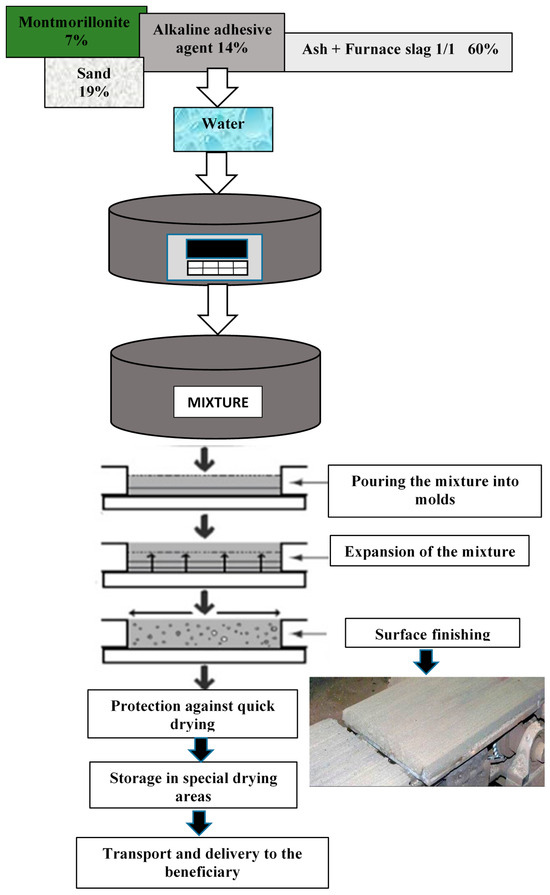
Figure 6.
Structural insulation panel manufacturing process flow.
Since geopolymerization is an exothermic process, the heat released during geopolymerization leads to a low increase in temperature. The experimental results indicated that the temperature of the mixtures is higher immediately after mixing and decreases during time and after mixing. This temperature decrease is stronger during the first 3 h of geopolymerization, an aspect that must be taken into account when addressing the casting technology.
3.2. Characterization of the Obtained Structural Insulation Panels
The panels were characterized by tests to determine apparent density, mechanical resistance to expansion and compression, and resistance and thermal conductivity. These were followed by specific functional tests to determine the acoustic absorption coefficient and the effectiveness of electromagnetic shielding. All presented values were obtained by averaging the values obtained from at least three different samples.
3.2.1. Apparent Density of the Panel in the Hardened State
Apparent density was determined by testing samples in the hardened state of a standardized prismatic shape, with the dimensions of the cross-section being 40 mm × 40 mm and the length 160 mm, according to [57]. The results are presented in Table 5.

Table 5.
Apparent density.
3.2.2. Strength to Stretching by Bending
The determination of the tensile strength of the panel by bending was carried out according to [48,58]. The strength of the material was determined on specimens in the form of prisms with dimensions of 40 mm × 40 mm × 160 mm, and the results are presented in Table 6.

Table 6.
Strength to stretching by bending.
3.2.3. Compression Strength
The compression strength test was performed according to [48,58]. The compression strength of the material was determined on specimens in the form of prisms with dimensions of 40 mm × 40 mm × 160 mm, and the results are presented in Table 7.

Table 7.
Compression strength.
3.2.4. Thermal Resistance and Thermal Conductivity
The tested specimens were in the form of a flat plate with parallel faces and dimensions of 300 mm × 300 mm × 20 mm, according to the procedure in [59].
The thermal resistance was determined by the thermofluxmetric method, [60,61], the thermal flow being measured in the central area of the sample. Values of the determined thermal resistance and thermal conductivity are presented in Table 8, and are based on the model in [62].

Table 8.
Thermal features.
3.2.5. Fire Resistance Tests
Fire resistance tests showed that when a 10 mm thick geopolymer panel was exposed to a flame with a temperature of 1100 °C, the temperature of the panel on the opposite side of the fire is a function of the initial concentration of NaOH, and, e.g., for P3, the temperature only reaches 260–270 °C after 35 min exposure. The same test was performed on geopolymer samples with different concentrations of ash. It was observed that geopolymers obtained with a higher quantity of furnace slag showed higher fire resistance, i.e., the temperature of the sample P6 on the opposite side to the fire did not increase more than 240–250 °C after 35 min exposure. Thus, the geopolymers produced from furnace slag can be considered a superior fire-resistant material with applications in construction engineering. This results is in line with the findings of [63]. A geopolymer material exposed to the action of high temperatures loses only part of its resistance, especially if the temperature range exceeds 600–700 °C.
3.2.6. Environment-Related Tests
The geopolymer composite panels were subjected to freezing and thawing cycles in aqueous medium. The results showed that the weight of the samples did not change during such cycles, and no disintegration of the geopolymer samples occurred, even after 100 cycles, but there was a decrease in compression strength of 24% on average. The results are in line with [64]. The geopolymer composites were then exposed to NaCl solution for 30 days. They exhibited corrosion resistance without showing signs of deterioration other than the weight of the samples increasing by about 2% due to the penetration of chloride ions into the geopolymer materials. A small increase in compression strength of 4% on average was also noticed. These results are in line with [65].
3.2.7. Determination of Resistance to Chemical Liquids (Solutions)
The chemical resistance tests were made upon plate-shaped samples with flat faces and straight edges and dimensions of 100 mm × 100 mm × 10 mm. The conditioning of the samples to be tested was carried out in the laboratory atmosphere, for 24 h, at a temperature of +230 °C ± 20 °C and a relative air humidity of 50% ± 5%. The samples (Figure 7) were immersed in liquid chemical solutions, namely, H2SO4—3%, HCl—5% (Figure 8), CH3COOH—3%, and synthetic engine oil (Figure 9), being kept in a state of total immersion for 48 h.
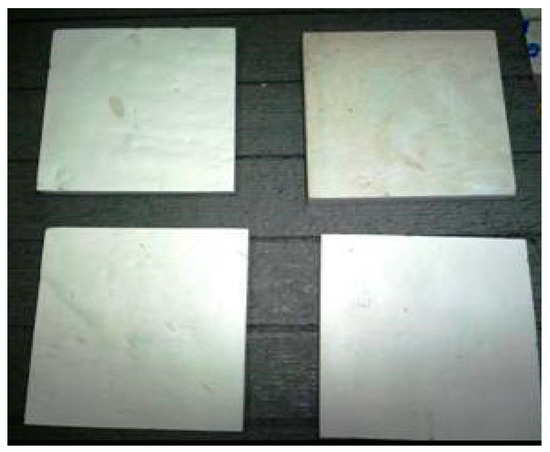
Figure 7.
Specimens before immersion.
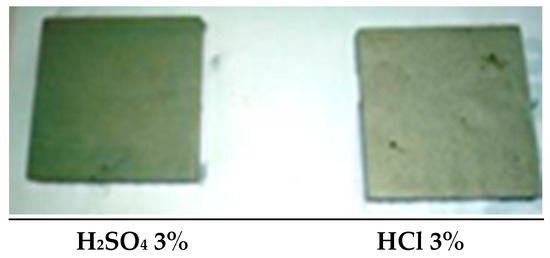
Figure 8.
Samples after total immersion for 48 h in H2SO4, left, and HCl, right.
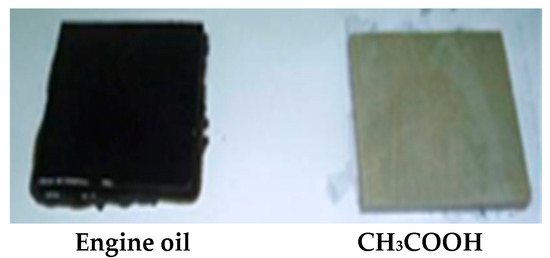
Figure 9.
Samples after total immersion for 48 h in synthetic engine oil, left, and CH3COOH, right.
An examination of the samples subjected to total immersion for 48 h in the liquid solutions showed no visual degradation. Comparatively, the results for immersion in H2SO4 solution were in line with the results in [27,29].
3.2.8. Measurement of Dielectric Properties
Table 9 presents the relative dielectric permittivity εr′ and the dielectric loss factor εr″ of the constituents. The experimental results classify the constituents into two groups of materials:

Table 9.
Dielectric properties of the constituents.
- -
- Water-based materials—consisting of water and alkaline solution (NaOH 12M). These have reasonable permittivity values, as water is a material with high dielectric losses, which corresponds to much higher permittivity values than other components;
- -
- Solids—containing ash, slag, and sand (saturated). This group has a small range of εr′ and εr”. The dielectric properties of this group of materials are lower than those of the group of water-based materials.
Each constituent element was cast in an acrylic formwork of 5 × 5 × 5 cm, after which the dielectric properties of the samples were measured at an ambient temperature of 24–25 °C. Immediately after casting, the dielectric properties of the samples were measured using a coaxial probe and evaluated using a network analyzer. The effect of the time elapsed after mixing on the properties of the geopolymer mortar was measured at 1, 3, 6, 12, and 24 h. The dielectric properties of the geopolymer mixtures were found to be strongly affected by the characteristics of the constituents and their proportion.
From these tests, it was found that, in time, the values of relative dielectric permittivity and dielectric loss factor became appreciably lower, i.e., after 24 h, approximately 5.2 and 0.76, respectively. This is due to the fact that, in the first stages of the reaction, the geopolymer has a large amount of free water and monomers as the main compositions; thus, in the first stages of the reaction, the rate of formation of dissolved monomers is higher than the rate of precipitation. The free water and monomers in the early phases are transformed into water of crystallization and polymer components, and so, the constituents in the quasi-liquid state present much higher values of dielectric constant and loss factor than the constituents in the solid state, because water and monomer are materials with high losses compared to the other components. In fact, for all mixtures, the dielectric values decrease with increasing time; however, in the absence of slag, the final values tend toward the values for ash. The presence of slag, with ferritic components, is what confers special dielectric properties, leading to panels with higher electromagnetic shielding properties.
3.2.9. Functional Acoustic Absorption Tests
In order to carry out the functional tests, samples with dimensions suitable for the testing devices were cut from the panels (Figure 10) in the form of discs with a diameter of 63.5 mm and a thickness of 10 mm, according to the procedure described in [66].
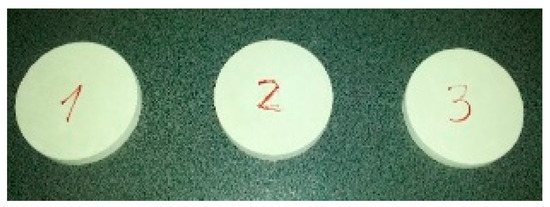
Figure 10.
Disc samples (identical) for functional acoustic absorption tests.
The determination of the acoustic absorption coefficient was carried out in accordance with the model in [66], and the results are presented in Figure 11 and Table 10.
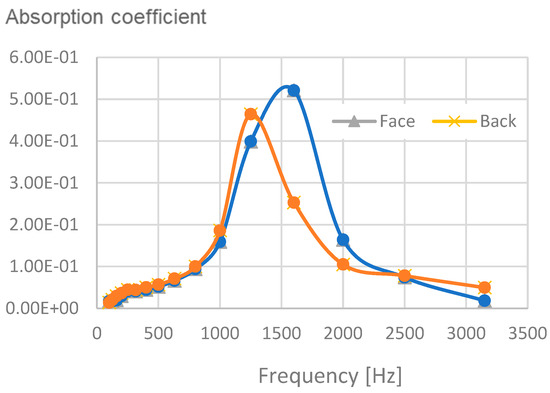
Figure 11.
Absorption coefficient-sample: face vs. back.

Table 10.
Absorption coefficient 1/3 octave.
The acoustic absorption coefficient seems to slightly depend on the position of the sample relative to the sound emitter, which can be ascribed to the fact that the panel, due to the maturation process, is not entirely homogeneous, i.e., it is expected that a small part of the heavier particles, in particular the slag, tend to preferentially accumulate at the base of the panel. The variation in the acoustic absorption coefficient is remarkable when taking into account the evolution vs. frequency, being at a maximum exactly around the frequency of maximum acuity of the human ear, around 1300 Hz, the curves practically following the natural curve of human ear acuity.
3.2.10. Functional Tests of Electromagnetic Shielding Properties
Masonry-like structures made with and without geopolymer panels (with ferrimagnetic inserts due to the presence of slag) were tested for electromagnetic shielding effectiveness [67]. The attenuation values are presented in two working modes, “Max hold” and “Average”, and the frequency domain was selected to respond to the technical requirements for WiFi 802.11, i.e., including the 860/900 MHz and 2400 MHz bands, specific to data transfer in construction.
The testing procedure was performed under the same conditions for masonry walls/structures as follows:
- -
- Autoclaved cellular concrete wall (ACC)—25 cm thick—Table 11;
 Table 11. The attenuation values for autoclaved cellular concrete wall.
Table 11. The attenuation values for autoclaved cellular concrete wall. - -
- 40 cm thick brick wall with 10 cm thick polystyrene (Brick)—Table 12;
 Table 12. The attenuation values for thick brick wall.
Table 12. The attenuation values for thick brick wall. - -
- Concrete (Portland cement) wall, 25 cm thick—classic recipe (Concrete)—Table 13;
 Table 13. The attenuation values for concrete (Portland cement) wall.
Table 13. The attenuation values for concrete (Portland cement) wall. - -
- Structural insulation panel with geopolymer matrix of 25 cm thick (Geopol)—Table 14.
 Table 14. The attenuation values for structural insulation panel with geopolymer matrix.
Table 14. The attenuation values for structural insulation panel with geopolymer matrix.
In Figure 12, the variation in electromagnetic field attenuation as a function of frequency is presented for the four masonry-like structures (in both “Max hold” and “Average” working modes). The value of the shielding effectiveness of the geopolymer panel structure is significant, particularly in the 860/900 MHz domain, especially since the thickness of the panel is approx. half that of the usual construction structures made of bricks. Even better attenuation can be expected to be achieved by increasing the percentage of blast furnace slag in the geopolymer structure. The remarkable behavior toward electromagnetic fields of the geopolymer panels encourages us to suggest such material concepts for complex shielding purposes, i.e., thermal, acoustic, and electromagnetic shielding, thus constituting a new concept in structural shielding.
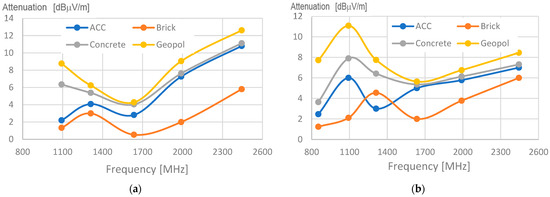
Figure 12.
Attenuation of the electromagnetic field vs. frequency: (a) “Max hold” working mode; (b) “Average” working mode.
4. Discussion
The ash used in this study presents high concentrations of SiO2 and Al2O3, close to metakaolin homolog concentrations, while the slag powder presents much lower concentrations of Al2O3, but relatively significant concentrations of Fe2O3, CaO, and MgO, which may provide interesting electromagnetic properties to the final composites. In addition, the technologically obtained metakaolin presents a particle size under 20 μm with a D50 of about 8.5 μm, very similar to the dimension of ash particles, so the use of critical wastes such as power plant ash instead of metakaolin within the fabrication of geopolymer composite concrete may bring high economic and environmental benefits, lowering energy costs.
Different recipes of composites were tested with different ratios of ash and slag and different concentrations of NaOH alkaline adhesive agent. It was noticed that the highest value for compression strength was achieved for geopolymers with the highest content of ash and the highest concentration of the alkaline adhesive agent. Samples submitted to hydrothermal treatment presented a faster maturation, with increased compression strength in the first 24 h. Hence, hydrothermal treatment may be regarded as a useful procedure when the geopolymer materials must be used after only 24 h of maturation, as compression strength reaches about 74.5% of the final value in this case.
Structural insulation panels were made in the laboratory from composites containing a 1:1 ratio of power plant ash and furnace slag. The results obtained for properties specific to construction applications (apparent density, mechanical resistance to stretching and compression, resistance and thermal conductivity, flame resistance) were in line with those of classical geopolymer composite panels made with metakaolin and sodium silicate. At the same time, some special properties, such as sound insulation and electromagnetic shielding properties for special applications, were tested. The results obtained from these functional tests found that the panels made of geopolymer composites obtained with the addition of power plant ash and furnace slag provided attenuation values clearly superior to those obtained for autoclaved cellular concrete, brick, or concrete from Portland cement, which encourages us to suggest such material concepts for complex shielding purposes, i.e., thermal, acoustic and electromagnetic shielding, thus constituting a new concept in structural shielding.
5. Sustainability Analysis for Structural Insulation Panels Constructed from Geopolymers Containing Power Plant Ash and Furnace Slag
Product sustainability is analyzed based on multiple technical, economic, ecological, and health criteria [68,69,70], based on objectives related to the requirements imposed on the product. Stage 1, the most important, is related to the mandatory technical attributes to be met by the product. Once there is certainty that the chosen technology leads to the optimal product from the technical point of view, in stage 2, the economic, ecological, and health criteria are analyzed.
In the case of structural insulation panels constructed from geopolymers containing power plant ash and furnace slag, the technical criteria are mainly met, as demonstrated by the results of the mechanical strength, durability, fire resistance, ease of construction/buildability, resistance to decay from salts and acids tests described above. This is also true in relation to additional special thermal, acoustic, and electromagnetic shielding properties. The analysis is based on the comparison with homolog structural insulation panels based on geopolymer structures available on the market (see, for example, [71,72,73,74,75]), as, generally speaking, structural insulated panels, whatever their technology, are one of the most efficient and sustainable construction materials, both during manufacture and construction and long after.
Socio-economic criteria include esthetics, use of local/waste materials, labor availability, maintenance and disposal costs, and energy costs. Health and safety issues must also be taken into account, including the risk of occupational injuries. Environmental impact criteria include environmental statutory compliance, low toxicity, ozone depletion potential, recyclability, embodied energy in material, pollution impact on air-soil-water, and the methods of extraction of the raw materials [76].
The structural insulation panels are exposed to environmental risks across their value chain, but mainly during product manufacturing and use, specifically, significant energy use, air emissions, and water consumption. In our case, waste management and product end-of-life offer advantages in terms of waste materials (power plant ash and furnace slag) used in the fabrication of the panels, with a high positive impact on the environment, and the potential reuse of panel waste as component material for other building products, thereby mitigating environmental risks and meeting the demand for more sustainable materials. In addition, it must be mentioned that geopolymer composites provide a stable encapsulation of heavy metals and harmful substances, in this way stabilizing such substances with a further high positive impact on the environment.
A qualitative evaluation and quantification of the criteria described above can be made by carrying out a life cycle analysis (LCA) of the product, a very important instrument for further product development and improvement. LCA can be integrated into the environmental management system as a basis for determining priorities. The methodology of LCA is related to [77] and covers the whole cycle of product life from raw materials, design, manufacture, to use and disposal, as an iterative process. In the literature, some examples of sustainability analysis are offered based on LCA (see, e.g., [78,79,80,81]), but these refer mainly to the technical and economic aspects of manufacturing processes.
This paper intends to make a qualitative evaluation and quantification of the criteria in order to achieve three comparative models of sustainability, one related to structural panels made of Portland cement, the second related to classical geopolymer composites, as in [74], and the last related to the structural panels described in this paper, made from geopolymers containing power plant ash and furnace slag.
The respective models take into consideration all stages of the product life cycle. The environmental impact is related to the main concerns, i.e., energy consumption, waste generation, and air–water–soil pollution. The scale is based on qualitative estimations, from 1 to 3, with 1 being minimal impact and 3 being critical impact. The impact was quantified based on each material’s environmental footprint, related to each stage of the product life cycle. The data are interpreted and the scale is correlated with the models described in [22,74] for structural panels made from Portland cement and classical geopolymer composites, respectively. As regards panels containing power plant ash and furnace slag, the scale is based on data in [81] for panels comparable with the panels described in this paper. The use of a quantification scale for the three materials decreases the degree of incertitude present in the qualitative estimation of the environmental impact of those materials because it reflects the hierarchy for each criterion. The results are presented in Table 15, Table 16 and Table 17.

Table 15.
Sustainability model for structural panels made from Portland cement.

Table 16.
Sustainability model for structural panels made from classical geopolymer composites.

Table 17.
Sustainability model for structural geopolymer composite panels containing power plant ash and furnace slag.
It can be seen that the structural panels made from geopolymer composites are more sustainable than those made from Portland cement (score 69 vs. 59), mainly due to higher pollution related to cement technology but also due to the larger consumption of energy and water. Conversely, the processability of structural panels made of Portland cement is lower than that of geopolymer composite panels, with lower maintainability and lower resistance to decay from salts and acids.
It can also be seen that the panels made with the addition of power plant ash and furnace slag are superior to the classical structural geopolymer composite panels (score 49 vs. 59), due to the absorption of critical waste as raw materials, absence of additives that need extra processing with additional consumption of energy, such as metakaolin and sodium silicate, and extra properties in terms of acoustic and electromagnetic shielding properties, thus representing a better socio-economical impact. The main benefit can be observed mainly when analyzing the first two lines of each table, i.e., the lines related to the raw materials used, in which structural panels made from Portland cement present a score of 27 and the classical structural geopolymer composite panels a score of 22, while the panels described in this paper present a score of 12, due to the arguments presented above.
6. Conclusions
This paper describes the process of obtaining geopolymer composites using raw materials from critical waste, specifically, power plant ash and furnace slag powder. The ash presents high concentrations of SiO2 and Al2O3, close to metakaolin homolog concentrations. Similarly, technologically obtained metakaolin presents a particle size very similar to the dimension of ash particles, so the use of critical waste such as power plant ash instead of metakaolin within the fabrication of geopolymer composite concrete brings high economic and environmental benefits, mainly in terms of technology simplification and energy cost reduction.
Different recipes of composites were tested with different ratios of ash and slag and different concentrations of NaOH. Using these geopolymer composites, structural insulation panels were made in the laboratory, which were then subjected to tests specific to construction applications (apparent density, mechanical resistance to stretching and compression, resistance and thermal conductivity, flame resistance). All achieved values were in line with those of classical geopolymer composite panels made with metakaolin and sodium silicate.
In addition, some special properties, such as sound insulation and electromagnetic shielding properties for special applications, were tested. The results obtained from these functional tests showed that the panels made of geopolymer composites provided attenuation values clearly superior to those obtained for autoclaved cellular concrete, brick, and concrete from Portland cement, which encourages us to suggest such material concepts for complex shielding purposes, i.e., thermal, acoustic and electromagnetic shielding, thus constituting a new concept in structural shielding.
The sustainability of the technology of the suggested geopolymer composites was demonstrated from the economic, environmental, and social perspectives when critical waste is used as raw materials for their fabrication, demonstrating their high economic and environmental benefit, and new applications are suggested with direct social impact upon building technologies. Product sustainability was analyzed based on multiple criteria. The models took into consideration all stages of the product life cycle. The environmental impact was measured relative to energy consumption, waste generation, and air–water–soil pollution. A scale for feature quantification based on qualitative estimations was used, ranging from 1 to 3, with 1 being minimal impact and 3 critical impact.
Three comparative models of sustainability were analyzed, one related to structural panels made of Portland cement, the second to classical geopolymer composites with metakaolin, and the last to the structural panels of the type proposed in this paper, with the addition of power plant ash and furnace slag. It can be seen that structural panels made from geopolymer composites are more sustainable than those made from Portland cement, mainly due to higher pollution related to cement technology but also due to a larger consumption of energy and water. Conversely, the processability of structural panels made from Portland cement is lower than that of geopolymer composite panels, with lower maintainability and lower resistance to decay from salts and acids.
The panels made with the addition of power plant ash and furnace slag are superior to classical structural geopolymer composite panels due to the absorption of critical waste as raw materials, absence of additives that need extra processing with additional consumption of energy, such as metakaolin and sodium silicate, and extra features in terms of acoustic and electromagnetic shielding properties, representing a better socio-economical impact. The main benefit can be observed when analyzing the criteria related to the raw materials used, where the panels described in this paper present an excellent score due to having the lowest environmental footprint.
The research work presented in this paper will be continued. This future work will include, on the one hand, the inclusion of other waste materials as raw materials for producing geopolymer composites, e.g., mining waste, or building waste materials from demolition operations, and, on the other hand, the testing of new recipes of such materials, to increase the performance with respect to acoustic and/or electromagnetic shielding for specialized structure. Finally, the respective materials will be tested for suitability for rapid 3D printing technologies in the building domain, as described in [82], but associated with quick hydrothermal maturation, for specialized use, or use in case of stringent necessity due to calamities.
Author Contributions
Conceptualization, C.S.; methodology, R.C.C., C.S. and A.R.C.; validation, R.C.C., C.S. and A.R.C.; formal analysis, A.R.C. and I.I.; investigation, R.C.C., C.S., A.R.C. and I.I.; data curation, R.C.C., C.S. and A.R.C.; writing—original draft preparation, C.S. and R.C.C.; writing—review and editing, R.C.C., C.S. and A.R.C.; visualization, R.C.C., C.S. and A.R.C.; supervision, C.S. and R.C.C. All authors have read and agreed to the published version of the manuscript.
Funding
This research received no external funding.
Institutional Review Board Statement
Not applicable.
Informed Consent Statement
Not applicable.
Data Availability Statement
The data presented in this study are available on request from the corresponding author.
Acknowledgments
The research was based on preliminary results of the project Eureka 5415/2011—“NEWCOMAT: Development of composite materials geopolymer ceramics, from waste industrial, with superior properties of electromagnetic and thermal shielding for special constructions”, and of the project number 25PFE/30.12.2021-Increasing R-D-I capacity for electrical engineering-specific materials and equipment with reference to electromobility and “green” technologies within PNCDI III, Programme 1.
Conflicts of Interest
The authors declare no conflicts of interest.
References
- Vallev, D.; Kondratiev, A. Current State of Coal Fly Ash Utilization: Characterization and Application. Materials 2023, 16, 27. [Google Scholar] [CrossRef]
- Suryani, F.M.; Rizal, S.; Abdullah, A.; Isya, M. Fly Ash Substitution in Lightweight Concrete for Rigid Pavement Construction on Low-Bearing-Capacity Soil. Sustainability 2023, 15, 15239. [Google Scholar] [CrossRef]
- Peceño, B.; Pérez-Soriano, E.M.; Luna-Galiano, Y.; Leiva, C. The Incorporation of Ladle Furnace Slag in Fire Insulating Gypsum-Based Materials. Fire 2023, 6, 416. [Google Scholar] [CrossRef]
- Ohemeng, E. Utilization of Blast Furnace Slag as an Enhancer in Masonry Mortars Made with Thermally Treated Waste Concrete Powder. Buildings 2023, 13, 2616. [Google Scholar] [CrossRef]
- Ige, O.E.; Olanrewaju, O.A.; Duffy, K.J.; Collins, O.C. Environmental Impact Analysis of Portland Cement (CEM1) Using the Midpoint Method. Energies 2022, 15, 2708. [Google Scholar] [CrossRef]
- Kim, Y.-J.; van Leeuwen, R.; Cho, B.-Y.; Sriraman, V.; Torres, A. Evaluation of the Efficiency of Limestone Powder in Concrete and the Effects on the Environment. Sustainability 2018, 10, 550. [Google Scholar] [CrossRef]
- Liew, Y.-M.; Heah, C.-Y.; Mohd Mustafa, A.B.; Kamarudin, H. Structure and properties of clay-based geopolymer cements: A review. Prog. Mater. Sci. 2016, 83, 595–629. [Google Scholar] [CrossRef]
- Giergiczny, Z.; Król, A.; Tałaj, M.; Wandoch, K. Performance of Concrete with Low CO2 Emission. Energies 2020, 13, 4328. [Google Scholar] [CrossRef]
- Ahmad, J.; Kontoleon, K.J.; Majdi, A.; Naqash, M.T.; Deifalla, A.F.; Ben Kahla, N.; Isleem, H.F.; Qaidi, S.M.A. A Comprehensive Review on the Ground Granulated Blast Furnace Slag (GGBS) in Concrete Production. Sustainability 2022, 14, 8783. [Google Scholar] [CrossRef]
- Merabtene, M.; Kacimi, L.; Clastres, P. Elaboration of geopolymer binders from poor kaolin and dam sludge waste. Heliyon 2019, 5, e01938. [Google Scholar] [CrossRef]
- Mohajerani, A.; Vajna, J.; Cheung, T.H.H.; Kurmus, H.; Arulrajah, A.; Horpibulsuk, S. Practical recycling applications of crushed waste glass in construction materials: A review. Constr. Build. Mater. 2017, 156, 443–467. [Google Scholar] [CrossRef]
- Lu, J.-X.; Poon, C.S. Recycling of waste glass in construction materials. In New Trends in Eco-Efficient and Recycled Concrete; Woodhead Publishing: Sawston, UK, 2019; pp. 153–167. [Google Scholar] [CrossRef]
- Rivera, J.F.; Cuarán-Cuarán, Z.I.; Vanegas-Bonilla, N.; de Gutiérrez, R.M. Novel use of waste glass powder: Production of geopolymer tiles. Adv. Powder Technol. 2018, 29, 3448–3454. [Google Scholar] [CrossRef]
- Lazorenko, G.; Kasprzhitskii, A.; Fini, E.H. Sustainable construction via novel geopolymer composites incorporating waste plastic of different sizes and shapes. Constr. Build. Mater. 2022, 324, 126697. [Google Scholar] [CrossRef]
- Alawi, A.; Milad, A.; Barbieri, D.; Alosta, M.; Alaneme, G.U.; Latif, Q.B.A.I. Eco-Friendly Geopolymer Composites Prepared from Agro-Industrial Wastes: A State-of-the-Art Review. CivilEng 2023, 4, 433–453. [Google Scholar] [CrossRef]
- Figiela, B.; Korniejenko, K.; Łach, M.; Azzopardi, B. A study on geopolymer composites based on waste from wind turbine blades. Mater. Und Werkst. 2022, 53, 467–478. [Google Scholar] [CrossRef]
- Tammam, Y.; Uysal, M.; Canpolat, O.; Kuranlı, Ö.F. Effect of Waste Filler Materials and Recycled Waste Aggregates on the Production of Geopolymer Composites. Arab. J. Sci. Eng. 2022, 48, 4823–4840. [Google Scholar] [CrossRef]
- Castillo, H.; Collado, H.; Droguett, T.; Vesely, M.; Garrido, P.; Palma, S. State of the art of geopolymers: A review. e-Polymers 2022, 22, 108–124. [Google Scholar] [CrossRef]
- Drechsler, M.K.; Graham, A. Geopolymers—An Innovative Materials Technology Bringing Resource Sustainability to Construction and Mining Industries. In Proceedings of the 48th Conference—Institute of Quarrying Conference, Adelaide, Australia, 12–15 October 2005; pp. 1–12. [Google Scholar] [CrossRef]
- Burduhos Nergis, D.D.; Abdullah, M.M.A.B.; Vizureanu, P.; Faheem, M.T.M. Geopolymers and Their Uses: Review. IOP Conf. Ser. Mater. Sci. Eng. 2018, 374, 012019. [Google Scholar] [CrossRef]
- Li, Y.-F.; Xie, Y.-X.; Syu, J.-Y.; Huang, C.-H.; Tsai, H.-H.; Cheng, T.-W.; Chen, Y.-C.; Lee, W.-H. A Study on the Influence of the Next Generation Colored Inorganic Geopolymer Material Paint on the Insulation Measurement of Concrete Building Shell. Sustainability 2022, 14, 164. [Google Scholar] [CrossRef]
- Habert, G.; d’Espinose de Lacaillerie, J.B.; Roussel, N. An Environmental Evaluation of Geopolymer Based Concrete Production: Reviewing Current Research Trends. J. Clean. Prod. 2021, 19, 1229–1238. [Google Scholar] [CrossRef]
- Available online: https://www.cbsnews.com/news/cement-industry-co2-emissions-climate-change-brimstone/ (accessed on 15 January 2024).
- Available online: https://ghgprotocol.org/sites/default/files/2023-03/co2-cement-epa_0.pdf (accessed on 15 January 2024).
- McLellan, B.C.; Williams, R.P.; Lay, J.; van Riessen, A.; Corder, G.D. Costs and carbon emissions for geopolymer pastes in comparison to ordinary portland cement. J. Clean. Prod. 2011, 19, 1080–1090. [Google Scholar] [CrossRef]
- Rangan, B.V. Engineering properties of geopolymer concrete. In Geopolymers; Woodhead Publishing: Sawston, UK, 2009; pp. 211–226. [Google Scholar] [CrossRef]
- Fernandez-Jimenez, A.; Palomo, A. Chemical durability of geopolymers. In Geopolymers; Woodhead Publishing: Sawston, UK, 2009; pp. 167–193. [Google Scholar] [CrossRef]
- Santa, R.A.A.B.; da Silva, A.F.V.; Padoin, N.; Soares, C.; Riella, H.G. Novel porous geopolymeric formulation as green material applied to the recovery of contaminated effluent aiming environmental protection. J. Clean. Prod. 2019, 231, 395–405. [Google Scholar] [CrossRef]
- Bayrak, B.; Mostafa, S.A.; Öz, A.; Tayeh, B.A.; Kaplan, G.; Aydın, A.C. The effect of clinker aggregate on acid resistance in prepacked geopolymers containing metakaolin and quartz powder in the presence of ground blast furnace slag. J. Build. Eng. 2023, 69, 106290. [Google Scholar] [CrossRef]
- Elsayed, M.; Tayeh, B.A.; Aisheh, Y.I.; Abd El-Nasser, N.; Abou Elmaaty, M. Shear strength of eco-friendly self-compacting concrete beams containing ground granulated blast furnace slag and fly ash as cement replacement. Case Stud. Constr. Mater. 2022, 17, e01354. [Google Scholar] [CrossRef]
- Hassan, A.; Arif, M.; Shariq, M.; Alomayri, T.; Pereira, S. Fire resistance characteristics of geopolymer concrete for environmental sustainability: A review of thermal, mechanical and microstructure properties. Environ. Dev. Sustain. 2022, 25, 8975–9010. [Google Scholar] [CrossRef]
- Amran, M.; Huang, S.-S.; Debbarma, S.; Rashid, R.S. Fire resistance of geopolymer concrete: A critical review. Constr. Build. Mater. 2022, 324, 126722. [Google Scholar] [CrossRef]
- Razak, S.N.; Shafiq, N.; Guillaumat, L.; Farhan, S.A.; Lohana, V.K. Fire-Exposed Fly-Ash-Based Geopolymer Concrete: Effects of Burning Temperature on Mechanical and Microstructural Properties. Materials 2022, 15, 1884. [Google Scholar] [CrossRef]
- Yang, W.; Zhu, P.; Liu, H.; Wang, X.; Ge, W.; Hua, M. Resistance to Sulfuric Acid Corrosion of Geopolymer Concrete Based on Different Binding Materials and Alkali Concentrations. Materials 2021, 14, 710. [Google Scholar] [CrossRef]
- Aiken, T.A.; Kwasny, J.; Sha, W. Resistance of fly ash geopolymer binders to organic acids. Mater. Struct. 2020, 53, 115. [Google Scholar] [CrossRef]
- Shcherban’, E.M.; Stel’makh, S.A.; Beskopylny, A.; Mailyan, L.R.; Meskhi, B. Increasing the Corrosion Resistance and Durability of Geopolymer Concrete Structures of Agricultural Buildings, Operating in Specific Conditions of Aggressive Environments of Livestock Buildings. Appl. Sci. 2022, 12, 1655. [Google Scholar] [CrossRef]
- Jiao, Z.; Li, X.; Yu, Q.; Yao, Q.; Guan, X.; Hu, P. Chloride resistance of class C/class F fly ash-based geopolymer mortars with different strength grades. Case Stud. Constr. Mater. 2023, 18, e01811. [Google Scholar] [CrossRef]
- Lach, M. Geopolymer Foams—Will They Ever Become a Viable Alternative to Popular Insulation Materials?—A Critical Opinion. Materials 2021, 14, 3568. [Google Scholar] [CrossRef]
- Azimi, E.A.; Abdullah, M.M.A.B.; Ming, L.Y.; Heah, C.Y.; Hussin, K.; Aziz, I.H. Review of Geopolymer Materials for Thermal Insulating Applications. Key Eng. Mater. 2015, 660, 17–22. [Google Scholar]
- Villaquirán-Caicedo, M.A.; Perea, V.N.; Ruiz, J.E.; de Gutiérrez, R.M. Mechanical. physical and thermoacoustic properties of lightweight composite geopolymers. Ing. Compet. 2021, 24, e20710985. [Google Scholar] [CrossRef]
- Ciaburro, G.; Iannace, G.; Ricciotti, L.; Apicella, A.; Perrotta, V.; Aversa, R. Acoustic Applications of a Foamed Geopolymer-Architected Metamaterial. Appl. Sci. 2024, 14, 1207. [Google Scholar] [CrossRef]
- Sharma, R.; Clower, W.; Amritphale, S.; Alam, S.; Matthews, J.; Radadia, A.D. Development of geopolymer composites for EMI shielding from steel industry waste. J. Mater. Sci. Mater. Electron. 2022, 33, 4847–4861. [Google Scholar] [CrossRef]
- Wanasinghe, D.; Aslani, F.; Ma, G. Effect of Carbon Fibres on Electromagnetic-Interference-Shielding Properties of Geopolymer Composite. Polymers 2022, 14, 3750. [Google Scholar] [CrossRef]
- Caramitu, A.R.; Ion, I.; Bors, A.M.; Tsakiris, V.; Pintea, J.; Caramitu, A.-M.D. Preparation and Spectroscopic Characterization of Some Hybrid Composites with Electromagnetic Shielding Properties Exposed to Different Degradation Factors. Mater. Plast. 2022, 59, 82–94. [Google Scholar] [CrossRef]
- Caramitu, A.R.; Ciobanu, R.C.; Ion, I.; Schreiner, C.M.; Aradoaei, M.; Tsakiris, V.; Pintea, J.; Marinescu, V. Flexible electromagnetic shielding nano-composites based on silicon and NiFe2O4 powders. Polymers 2023, 15, 2447. [Google Scholar] [CrossRef]
- Caramitu, A.-R.; Mitrea, S.; Marinescu, V.; Ursan, G.-A.; Aradoaie, M.; Lingvay, I. Dielectric behavior and Morphostructural Characteristics of Some HDPE Composites/Metal Nanopowders. Mater. Plast. 2019, 56, 103–106. [Google Scholar] [CrossRef]
- Lungu, M.V.; Pătroi, D.; Marinescu, V.; Caramitu, A.; Marin, M.; Tălpeanu, D.; Lucaci, M.; Godeanu, P. Preparation and study of the optical, electrical and dielectric characteristics of some disc-shaped tin dioxide-based varistors. Rom. J. Phys. 2022, 67, 610. [Google Scholar]
- EN 1015-11:2019; Methods of Test for Mortar for Masonry—Part 11: Determination of Flexural and Compressive Strength of Hardened Mortar. European Committee for Standardization (CEN): Brussels, Belgium, 2019.
- ISO 9277:2022; Determination of the Specific Surface Area of Solids by Gas Adsorption BET Method. ISO: Geneva, Switzerland, 2022.
- ASTM E1252-98; Standard Practice for General Techniques for Obtaining Infrared Spectra for Qualitative Analysis. ASTM: West Conshohocken, PA, USA, 2021.
- ISO 10534-2:2023; Acoustics Determination of Acoustic Properties in Impedance Tubes. ISO: Geneva, Switzerland, 2023.
- Firdous, R.; Stephan, D.; Djobo, J.N.Y. Natural pozzolan based geopolymers: A review on mechanical, microstructural and durability characteristics. Constr. Build. Mater. 2018, 190, 1251–1263. [Google Scholar] [CrossRef]
- Li, N.; Zhang, Z.; Shi, C. Some Progresses in the Challenges for Geopolymer. IOP Conf. Ser. Mater. Sci. Eng. 2018, 431, 022003. [Google Scholar] [CrossRef]
- ASTM D 5890-19; Standard Test Method for Swell Index of Clay Mineral Component of Geosynthetic Clay Liners. ASTM: West Conshohocken, PA, USA, 2019. Available online: https://www.astm.org/d5890-19.html (accessed on 15 January 2024).
- ASTM D 5891-01; Standard Test Method for Fluid Loss of Clay Component of Geosynthetic Clay Liners. ASTM: West Conshohocken, PA, USA, 2021. Available online: https://www.astm.org/d5891-01.html (accessed on 15 January 2024).
- ASTM D 570-22; Standard Test Method for Water Absorption of Plastics. ASTM: West Conshohocken, PA, USA, 2022. Available online: https://www.astm.org/standards/d570 (accessed on 15 January 2024).
- ISO 1920-5:2018; Testing of Concrete Part 5: Density and Water Penetration Depth. ISO: Geneva, Switzerland, 2018.
- SR EN 1015-10:2002; Methods of Testing Masonry Mortars. Part 10: Determination of Apparent Density of Hardened Mortars. ASRO: Bucharest, Romania, 2002.
- SR EN 12667:2000; Thermal Performance of Construction Materials and Products. ASRO: Bucharest, Romania, 2000.
- ISO 8990; Thermal Insulation—Determination of Steady-State Thermal Transmission Properties—Calibrated and Guarded Hot Box. International Organization for Standardization: Geneva, Switzerland, 1994.
- ASTM C1363-05; Standard Test Method for Thermal Performance of Building Materials and Envelope Assemblies by Means of a Hot Box Apparatus. ASTM: West Conshohocken, PA, USA, 2005.
- Bruno, R.; Bevilacqua, P.; Cuconati, G.; Arcuri, N. An innovative compact facility for the measurement of the thermal properties of building materials: First experimental results. Appl. Therm. Eng. 2018, 143, 947–954. [Google Scholar] [CrossRef]
- Cheng, T.; Chiu, J.P. Fire-resistant geopolymer produce by granulated blast furnace slag. Miner. Eng. 2003, 16, 205–210. [Google Scholar] [CrossRef]
- Tang, Z.; Deng, N. Effect of Salt Solution on the Mechanical Behaviours of Geopolymer Concrete under Dry-Wet Cycles. Hindawi—Adv. Mater. Sci. Eng. 2022, 2022, 9120821. [Google Scholar] [CrossRef]
- He, W.; Liu, C.; Zhang, L. Effects of NaCl on the Mechanical Properties of Slag Composite Matrix Geopolymer. Adv. Cem. Res. 2018, 31, 389–398. [Google Scholar] [CrossRef]
- SR EN ISO 10354-2:2010; Construction Acoustics. Determination of the Acoustic Absorption Coefficient and the Acoustic im-Pedance of Materials by the Acoustic Interferometer Method. International Organization for Standardization: Geneva, Switzerland, 2010.
- Available online: https://www.nist.gov/publications/electromagnetic-signal-attenuation-construction-materials (accessed on 15 January 2024).
- Zimmermann, H.; Gutsche, L. Multi-Criteria Analyse—Einführung in die Theorie der Entscheidungen bei Mehrfachzielsetzungen; Springer: Berlin/Heidelberg, Germany, 1991; ISSN 1431-4061. [Google Scholar]
- Akadiri, P.O.; Olomolaiye, P.O.; Chinyio, E.A. Multi-criteria evaluation model for the selection of sustainable materials for building projects. Autom. Constr. 2013, 30, 113–125. [Google Scholar] [CrossRef]
- Materials—ESG Evaluation, Key Sustainability Factors. Available online: https://www.spglobal.com/_assets/documents/ratings/research/100146568.pdf (accessed on 15 January 2024).
- Li, Z.; Chen, W.; Hao, H.; Xu, C.; Pham, T. Experimental and analytical study on structural performance of reinforced lightweight geopolymer composites panels. Structures 2023, 51, 1219–1229. [Google Scholar] [CrossRef]
- Kanagaraj, B.; Kiran, T.; Gunasekaran, J.; Nammalvar, A.; Arulraj, P.; Gurupatham, B.G.A.; Roy, K. Performance of Sustainable Insulated Wall Panels with Geopolymer Concrete. Materials 2022, 15, 8801. [Google Scholar] [CrossRef]
- Available online: https://patentimages.storage.googleapis.com/dc/b3/13/1c32d126587b19/WO2011029149A1.pdf (accessed on 15 January 2024).
- Kanagaraj, B.; Kiran, T.; Gunasekaran, J.; Nammalvar, A.; Arulraj, P.; Gurupatham, B.G.A.; Roy, K. Structural Behavior of Geopolymer Concrete Thin Wall Panels Based on Metakaolin and Recycled Concrete Aggregate. OCEJ 2019, 13, 109–117. [Google Scholar] [CrossRef]
- Tong, K. Lightweight Geopolymer Concrete Panels for a wall in high-rise buildings: Technical—Economical-Environmental efficiency. IOP Conf. Ser. Mater. Sci. Eng. 2020, 869, 032048. Available online: https://iopscience.iop.org/article/10.1088/1757-899X/869/3/032048/pdf (accessed on 15 January 2024). [CrossRef]
- Venditti, R. Life cycle analysis (LCA) and sustainability assessment, Forest Biomaterials, North Carolina State University, USA. Available online: https://faculty.cnr.ncsu.edu/richardvenditti/wp-content/uploads/sites/24/2018/10/IntroductiontoLCAAU32013.pdf (accessed on 15 January 2024).
- ISO 14044: 2006(E); Environmental Management—Life Cycle Assessment—Requirements and Guidelines. ISO: Geneva, Switzerland, 2006. Available online: https://www.iso.org/obp/ui/#iso:std:iso:14044:ed-1:v1:en (accessed on 15 January 2024).
- Cárdenas, J.P.; Muñoz, E.; Hidalgo, F. Simplified life cycle assessment applied to structural insulated panels homes. Rev. Ing. De Construcción 2015, 30, 33–38. [Google Scholar] [CrossRef][Green Version]
- EPS Recycling Advancements & Technology Innovations, Structual Insulated Panels Reduce Global Warming: Life Cycle Benefits of SIPs. Available online: https://www.sips.org/documents/SIPs-Life-Cycle-Analysis-Brochure.pdf (accessed on 15 January 2024).
- Yang, X.; Fan, S.; Li, Y.; Guo, Y.; Li, Y.; Ruan, K.; Zhang, S.; Zhang, J.; Kong, J.; Gu, J. Recovery of electronic wastes as fillers for electromagnetic shielding in building components: An LCA study. J. Clean. Prod. 2021, 280, 105670. [Google Scholar] [CrossRef]
- Shi, X.; Zhang, C.; Liang, Y.; Luo, J.; Wang, X.; Feng, Y.; Li, Y.; Wang, Q.; Abomohra, A.E.-F. Life Cycle Assessment and Impact Correlation Analysis of Fly Ash Geopolymer Concrete. Materials 2021, 14, 7375. [Google Scholar] [CrossRef]
- Qaidi, S.; Yahia, A.; Tayeh, B.A.; Unis, H.; Faraj, R.; Mohammed, A. 3D printed geopolymer composites: A review. Mater. Today Sustain. 2022, 20, 100240. [Google Scholar] [CrossRef]
Disclaimer/Publisher’s Note: The statements, opinions and data contained in all publications are solely those of the individual author(s) and contributor(s) and not of MDPI and/or the editor(s). MDPI and/or the editor(s) disclaim responsibility for any injury to people or property resulting from any ideas, methods, instructions or products referred to in the content. |
© 2024 by the authors. Licensee MDPI, Basel, Switzerland. This article is an open access article distributed under the terms and conditions of the Creative Commons Attribution (CC BY) license (https://creativecommons.org/licenses/by/4.0/).
